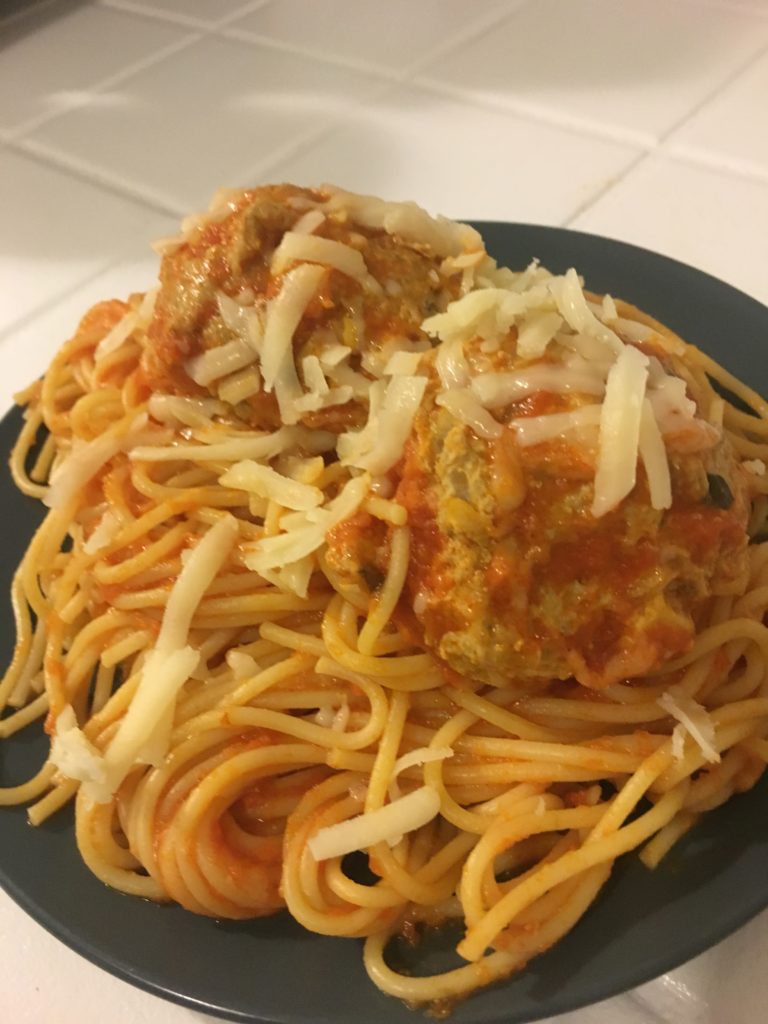Spaghetti is thought of as a traditional Italian dish, but it was actually created in The United States. As a large amount of Italians migrated from the 1800-1921, pasta dishes became popular in America. There were a number of factors, taking place at the turn of the twentieth century, that helped create the dish most of us know as spaghetti. Between 1880 and 1920 five million Italians immigrated to the United States due to the growth of Fascism in Italy. The diet of Italian immigrants shifted once in America, and meat became a larger part of their diet since it was much more affordable in the U.S. than Italy. Spaghetti pasta is traditionally made with marinara sauce which consist of tomatoes, onion garlic and herbs. The use of tomato sauces became very popular because the ingredients were easy to find, were very affordable and it was a quick sauce to make. Traditionally, meatballs for this dish, are made with beef, pork, or combination of both. Finally, once the pasta and meatballs are plated, it is usually topped with cheese and herbs once served
Pasta is also often thought of as being originally from Italy and perhaps it is, but it is popular belief that Marco Polo introduced Italy to pasta when he returned from a trip to China. It later became a staple in the Italian diet. Pasta is incredibly versatile. It comes in different forms like, lasagna, macaroni, linguini, and spaghetti, just to name a few. It can also be topped and mixed with a verity of sauces including pesto, tomato and cream sauces. Pasta is now enjoyed by millions around the world, but it took certain factors to create the dish we know now as spaghetti. The combination of the large population of Italians in New York City, along with the availability and affordability of its ingredients, made spaghetti an American favorite. Spaghetti represents both tradition and new beginnings because Italians were able to create something new by using what was available in a new land to create something that still felt like home.

The best spaghetti I have ever had is my grandmother’s spaghetti. She passed away two years ago and had stopped cooking years before that, but when she still cooked, she used to make spaghetti and meatballs on a regular basis. My grandmother was not from Italy, but from Mexico City. Like many other immigrants, my grandmother came to the U.S. in hopes of something better for herself and her children. My grandmother had a nickname that everyone would call her, Jechu. The name is a play on two Spanish words; Jefa meaning female boss, and chula meaning pretty. My uncle Tony, one of my grandmothers nine children, gave my grandmother this name and it could not have been more appropriate for her. Ever since I was young she always had the same appearance; she never changed. She was under five feet tall, had short curly red hair and a voice so stern, just with her saying my name, I would think I was in trouble when I knew I hadn’t done anything. I suppose being a single mother of nine children would do that. She had to show who was in charge and the family for sure knew who was, Jechu. After retirement, she was always either in her garden tending to the plants, sitting in her recliner in her room watching her daytime T.V., or in the kitchen feeding what seemed like a small army.
Jechu was a master in the kitchen. Cooking was effortless for her, she would whip up classic Mexican dishes like chicken enchiladas, chili rellenos, and mole, sopes, rice, beans, salsas; she did it all and she did it the best. She also would cook American inspired dishes with her own twist on them. She would make hamburgers with a tomato salsa to replace Thousand Island dressing, and my all-time favorite ,her spaghetti and meat balls. It seemed to be something she concocted in the kitchen, but it was probably what she made with what she had. The sauce is made with a base of onion, garlic and tomato sauce like a traditional marinara sauce, but the hardboiled egg found in meat balls was a twist. Although it may sound strange, it is delisious.
Growing up my grandmother would take care of my sister and me after we would get out of school. She became our babysitter after our paternal grandmother moved away and wasn’t able to take care of my sister and me anymore. My sister and I were not happy with the change. My paternal grandmother, who we call Ama, which translates to Mom in English, was always so loving and caring with. She always hugged us and showed affection. Jechu was not that kind of woman. I’m sure she had her reasons for being so cold and direct. She grew up near Mexico City, and had nine children with a man who later left her to start another family elsewhere. He also became abusive and for that reason she came to the U.S. with her nine kids, trying to find somewhere safe and where she had opportunity.
Through all her struggles, Jechu really had one area where she would truly shine; she was a master in the kitchen. Cooking was effortless for her. She would whip up Mexican dishes like chicken enchiladas, chili rellenos, and mole, sopes, rice, beans, salsas. After my mom would get off of work she would pick up my sister and I up but of course we would have dinner first. It was definitely a full house every evening for dinner. My grandmother lived with two of my uncles, my aunt, and my cousin, and with my parents, sister and I, there was just enough room for us to fit at the dinner table. There were also a lot of people that would come over for dinner. My uncle’s friends would stop by, usually taking the kids spot at the table or having people eat in rounds so everyone would be able to sit and eat. One group would sit and enjoy their meal, while the next group waited their turn. The rotation of people at the dinner table seemed endless at times, but Jechu would never complained about people stopping by to eat. My grandmother lived for the compliments on her food. As soon as someone was done greeting her after walking through her doors, she would offer up whatever was on the stove that day, even offer left overs if someone didn’t like what she would have cooking up that day. When someone rejected her food, which was not often, she took offence. Although she had a tough exterior, there was a warm loving feeling when eating her food, as if she was making up for her cold demeanor through her cooking.
When I was thirteen the family took a trip to Las Vegas. It didn’t matter where we went but my grandma complained about the food. It was either missing flavor or she would say that she could have made it better. While in Vegas we stayed somewhere with a kitchen and when it came down to dinner time, Jechu asked what we wanted to eat, and spaghetti and meatballs it was. My sister, who is one year younger than me, and I also thought this is our chance to learn her recipe. We had already been helping my mother in the kitchen by this age mainly chopping and peeling, but not making full meals. Jechu was a bit hesitant to give up her recipe since she really didn’t give them out, but when she agreed we were ready to learn. My sister and I got ready with pen and paper, and watched my grandma do her magic. She started making the sauce, made from a base of onion, garlic and tomatoes, which I later learned was the base of most her dishes that had tomato sauce. She continued to add spices and herbs to the sauce. She didn’t measure anything, which made getting the recipe slightly difficult. She continued by making the meatballs, which were my favorite part of the dish. The meatballs, or albondigas in Spanish, were filled with a hardboiled egg. Cutting into the meatball was truly unique. Spices, herbs and rice were all visible in the meat and the hard-boiled egg stuck out like a sore thumb, but was also somehow the star of the dish. The dish can be adjusted to taste and in the more recent years of making it, I have used ground turkey instead of the ground beef my grandmother used to use, I now eat a plant-based diet and although this is far from being vegan I wanted to share a recipe that was meaningful to my family and me.

Recipe for Jechu’s Spaghetti and albondigas
Ingredients
1 pound of spaghetti pasta
2 tablespoons of olive oil
2 tablespoons of salt
Sauce
1 small yellow onion
4-5 Tomatoes
3-5 cloves of garlic
Large (29 oz) can of tomato sauce
1 ½ tablespoons of Knorr chicken bouillon (any other bullion can be used)
1 teaspoon of garlic powder
1 teaspoon of onion powder
1 teaspoon of oregano
½ teaspoon of cumin
1 tablespoon of vegetable oil
8oz. of Monterey Jack cheese
Meatballs
1 pound of ground beef or ground turkey
1 teaspoon of garlic powder
1 teaspoon of onion powder
1 teaspoon of oregano
1 teaspoon of ground black pepper
½ teaspoon of cumin
½ teaspoon of salt
1 tablespoon of fresh chopped mint
½ cup of cooked rice
1 egg (raw)
2-3 eggs (hard-boiled)
Directions
Start by making the sauce first. Adding tomatoes, onion and peeled garlic into a blender along with a half a cup of water, and blend on high speed until smooth. Heat saucepan on medium heat, coat the bottom with vegetable oil, add blended ingredients to the heated saucepan and let simmer for 15-20 min. Add tomato sauce, and remaining ingredients with 1 cup of water and let simmer on low for 30-45min. Stir occasionally.

For the meatballs start by making hardboiled eggs, peel, and cut each egg into 4 pieces and set aside. In a bowl, add the meat of your choice along with all other meatball ingredients and mix. Each piece of egg will be placed inside the meatball by taking about an ounce of meat, forming it flat on the palm of your band, placing the hardboiled egg in the middle, and then wrapping the meat around egg, forming a meatball. The size of the meatballs will be based on how large the piece of hardboiled egg is,and can be modified to personal preferences. Once all the meatballs are formed they are added into the simmering tomato sauce. Cook for 15-20 minutes until meat has been cooked through.


Next, for the spaghetti bring a pot of water to boil (add oil and salt). Cook spaghetti pasta as directed. Once pasta is done cooking, drain and add to sauce along with the cheese. Mix until pasta is coated in sauce. Extra cheese can also be added as garnish, and it is ready to serve.

